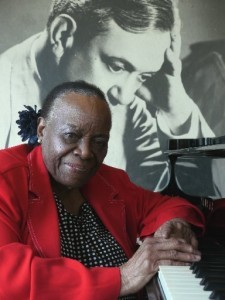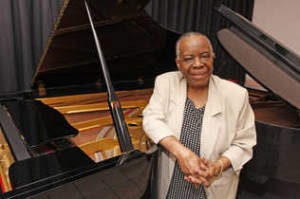 Zenaida Manfugás (February 22, 1932 – May 2, 2012) was a Cuban born, American naturalized pianist, considered to be one of the best Cuban pianists in history.
Zenaida Manfugás (February 22, 1932 – May 2, 2012) was a Cuban born, American naturalized pianist, considered to be one of the best Cuban pianists in history.
Zenaida Elvira González Manfugás was born on February 22, 1932 in Guantanamo, Cuba. Her father was Amado González Veranés and her mother, Andrea Manfugás Crombet, was a renowned pianist and teacher. She had two sisters: Alicia and Aida Esther. Her mother was a descendant of Nene Manfugás, a renowned composer and performer of Sonnets in the early 20th century.
Her family moved to Baracoa, where her father was appointed municipal judge and her mother opened a music school affiliated with the Conservatorio Orbón. Manfugás and her sisters began piano lessons at the age of five, under their mother’s tutelage. At age seven, Manfugás was able to play Mozart Coronation Mass, and Beethoven Concerto 5 .
Manfugás debuted in 1949 in Havana, in the Anfiteatro de Avenida del Puerto with the Municipal Band conducted by master Gonzalo Roig, playing “Concerto in A Minor” by Edvard Grieg. This became a frequent venue for Manfugás.
She studied in Santiago de Cuba. Three years after her debut, Manfugás received a scholarship to study in Spain. Journalist Agustín Tamargo had directed the attention of the then President of the Colegio de Belén University in Havana, Father Joseph Rubino, to the pianist and persuaded him to give her the scholarship. Roig then invited her to give a concert at Havana’s Cathedral Square.
In 1952, at the age of 20, Manfugás left Cuba and enrolled at the Real Conservatorio Superior de Música de Madrid (Royal Conservatory of Music of Madrid).and she was under the tutelage of Professor Tomas Andrade de Silva. She performed concerts and premieres in Spain, where she released the Dos Danzas (two Dances), by Cuban composer Harold Gramatges in 1953. She then traveled to Paris to receive lessons from master Walter Gueseking.
On her return to Cuba, in 1958, she was finally scheduled to give a concert at the Auditorium Theater on December 21 of that year. The organizers advised her to postpone it until January 9, 1959, but by then the country was in the revolutionary ferment of the triumph of Fidel Castro’s guerrilla movement and the pianist had to keep waiting for her big presentation in Cuba. It was not until 1960, when the theater had already been named “Amadeo Roldán,” that she was able to play her music at the main concert hall of that country.
In Cuba she was appointed professor at the Alejandro García Caturla Conservatory in Marianao. Manfugás was very active as a pianist in Cuba, and sometimes accompanied classical orchestras, such as the National Symphony Orchestra and the National Chamber Orchestra. She performed concerts with the National Symphony Orchestra, and conducted multiple tours in Europe (in places like Belgium and Russia and Asia (in countries like China and Japon, for which she was widely praised. Later, she also played in Canada. The pianist came to occupy the position of National Advisor in the cathedra of piano at the Amadeo Roldan Conservatory in Havana, until the early 1970s, when she took a trip to Spain never to return to Cuba.
Manfugás came to the United States in 1974, to play her music throughout the 50 states, and settled in the country. In 1979, she visited Cuba for the last time.
In exile, Manfugás played her music in places like Spain, Paris, Italy, New York and Miami. She also performed as a soloist with the New World Symphony Orchestra in Miami and was a professor at Kean University of New Jersey, where she taught History of Music. In December 2010, already ill, she was honored by the Apogee Foundation at the Cuba Ocho Cultural Center of Miami. At that time she could not play the piano because she was recovering from a recent surgery.
Her final performance in Miami, where she used to play her music frequently, took place on May 22, 2011 with “Tres pianos, Tres intérpretes” (“Three pianos, Three performers”), a concert held at the Wertheim Performing Arts Center – Florida International University, where she alternated with [the Master Jesus?] and Eugenia Ruspoli Armengol.
She had cancer and suffered from several health complications. Zenaida Manfugás died on May 2, 2012, at 4:30 pm ET in Elizabeth, New Jersey, where she had lived since 1974. According to different sources, she died due to a cardiac arrest or cancer. Her remains were cremated on Sunday May 13, 2012.
Personal life.
She settled in Elizabeth, New Jersey, in 1974. When she became a U.S. citizen, she adopted her mother’s maiden name in her honor, since her mother had taught her how to play the piano, . In 1955, she gave birth to a son in Spain, fathered by Andrés Montes, who over the years became one of the most popular sports journalists of radio and television in that country and who died in 2009 at age 53.
Curiosities.
Cuban musician Gonzalo Roig said that Zenaida Manfugás was the best interpreter of Cuban music, and one of the best pianists that Cuba had produced, and Lecuona himself regarded her also as the best interpreter of his music, for the special talent that ran in her rendering of his compositions. She was a great reader and borrowed books from the library every month. She never recorded a studio album.
The recordings that exist of her performances were made live. She recorded several albums interpreting the works of Cuban composers. She recorded two volumes entitled “Por siempre Lecuona” (Lecuona Forever) (1999), produced with her performances at different times. Those volumes contain the most popular works of the composer. At the time of her death, she lived in a modest apartment for the elderly and, like many other composers of classical music, died in poverty.
Agencies/Various/Wiki/InternetPhotos/youtube/thecubanhistory.com
The Cuban History, Hollywood.
Arnoldo Varona, Editor.



 Zenaida Manfugás, considered one of the best Cuban pianists. (born in Guantanamo) ** Zenaida Manfugás, considerada una de las mejores pianistas en la historia cubana.
Zenaida Manfugás, considered one of the best Cuban pianists. (born in Guantanamo) ** Zenaida Manfugás, considerada una de las mejores pianistas en la historia cubana.

